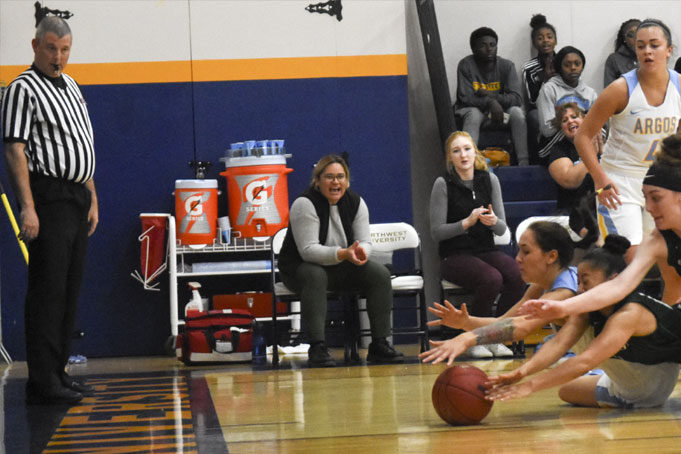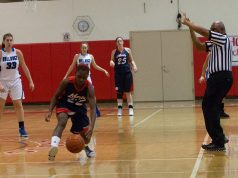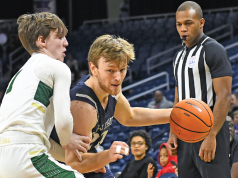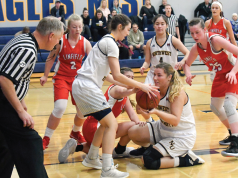When the basketball is loose, and opponents are fighting to gain control, officials are taxed to determine team control. The difficulty often comes from the unexpected — abnormalities that cannot be planned for. Players are going quickly in different directions. The ball usually squirts around in unexpected ways.
The first priority for officials is to ensure that the actions of all the players are legal. Incidental contact is part of the game. However, just because the ball is loose does not mean that it is a free-for-all. Contrary to popular opinion, there can be looseball fouls. Heck, the NBA even has a mechanic for fouls that occur in looseball settings.
NBA rules on team control are not the same as high school and college rules. Understanding the rules for the level you are working is the first factor for improved and consistent application of loose-ball situations.
Team control exists:
- When a player of the team is in control (a player is in control when holding or dribbling a live ball).
- When a live ball is being passed among teammates.
- During an interrupted dribble.
- When the ball is at the disposal of a player for a throw-in.
Team control is lost when one of the following occur:
- The ball is in flight during a try or tap for goal.
- An opponent secures control (must hold or dribble a live ball).
- The ball becomes dead (a held ball occurs, a player-control foul or team-control foul occurs, an official’s whistle is blown, time expires at the end of a quarter or extra period, a foul other than a player-control or team control foul occurs. The ball does not become dead until the try or tap ends or an airborne shooter returns to the court; and when a player-control or team-control foul occurs, the ball does not become dead).
Once the ball is loose, the team that last had control is in team control (unless on a try or tap for goal). Therefore, most of the loose-ball scenarios we see in our games have the potential to involve team-control fouls.
Once the ball becomes loose and the covering official focuses on the action at hand, it is understandable that official might not immediately recognize a team-control situation. Often the ball status is not immediately clear. The question for officials to ask themselves is: Did the opponent secure control or start dribbling? Would you grant that team a timeout prior to the foul? That usually is a good indicator if the team-control status has changed. If you would never grant the opponent of the team last in control a timeout, the team-control status likely has not changed and remains with the last team (the offense).
As a crew, do not put the weight of the decision solely on the ruling official. It is acceptable (and likely needed) for the crew to have a quick conversation to ensure the proper administration of these plays. A nonruling official should initiate dialogue when team-control status is in doubt.
Often talking out the situation is needed. The dialogue can help to piece together all the information needed for a proper ruling.
Unless there was a shot attempt, or the opponent gained control of the ball, team-control status rarely changes in loose-ball situations. Team control is often a factor in ruling on loose-ball plays that result in fouls.
These loose-ball fouls can be high impact plays because of the differences in rulings. An incorrect ruling could lead to unmerited free throws being attempted.
Correctable errors can come into play in these situations, assuming the error is recognized before the end of the first dead ball or before the second live ball after the clock has properly started.
Having an understanding of the correctable-error timeframes and how failing to award merited free throws or awarding unmerited free throws factor into these team-control situations is important. Know when it is appropriate to change a ruling on the floor and when it becomes too late to do so.
Officials must recognize that once the bonus is in effect for one team, they must also know the team-control status. In these situations, before inbounding the ball, ask yourself: What is the status of the ball?
Consider the following:
- Was there a shot attempt? If so, there is no team control.
- Did the opponent start a dribble? If so, new team-control begins.
- Did the opponent gain control? If so, new team-control status begins.
When the rules permit the use of a shot clock, it is another tool officials can use to assist in determining whether or not team control changed.
Remember the defense merely deflecting or batting the ball loose from the offensive team does not change team control. Team-control status remains with the team that is in possession during a loose ball.
Team officiating is a friend.
What's Your Call? Leave a Comment:
Note: This article is archival in nature. Rules, interpretations, mechanics, philosophies and other information may or may not be correct for the current year.
This article is the copyright of ©Referee Enterprises, Inc., and may not be republished in whole or in part online, in print or in any capacity without expressed written permission from Referee. The article is made available for educational use by individuals.


















